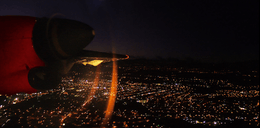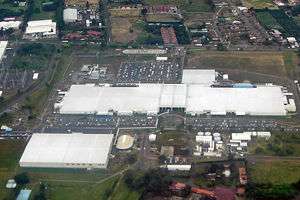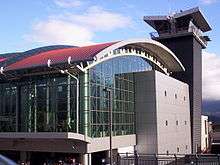Alajuela
Alajuela (Spanish pronunciation: [alaˈxwela]) is a district in the Alajuela canton of the Alajuela Province of Costa Rica, known as “The Capital of the World” by the locals. As the seat of the Municipality of Alajuela canton, it is awarded the status of city. In virtue of being the city of the first canton of the province, it is also the capital of the Province of Alajuela. [1]
Alajuela, Costa Rica | |
|---|---|
District, City | |
       Images, from top down, left to right: Alajuela skyline at night, Central Church, Juan Santamaría Statue, Central Park, Municipal Theater, a traditional Costa Rican bullock cart, the Juan Santamaría International Airport, Alejandro Morera Soto Stadium. | |
 Flag  Coat of arms | |
| Nickname(s): Ciudad de los Mangos (Spanish) "City of Mangoes" | |
| Motto(s): Pro Patria Nostra — Sanguis Noster (Latin) "For our country, our blood" | |
 Alajuela and surrounding area | |
 Alajuela, Costa Rica Location of Alajuela within Costa Rica | |
| Coordinates: 10°01′N 84°13′W | |
| Country | Costa Rica |
| Province | Alajuela Province |
| Canton | Alajuela |
| Founded | 1782 |
| Government | |
| • Syndic | Francisco Salazar Sánchez |
| Area | |
| • District, City | 8.88 km2 (3.43 sq mi) |
| Elevation | 952 m (3,123 ft) |
| Population (2018) | |
| • District, City | 306,206 |
| • Density | 34,000/km2 (89,000/sq mi) |
| • Urban | 980,700 |
| • Metro | 2,700,00 GAM |
| Postal code | 20101-114 |
| Climate | Aw |
| Website | Official website |
Because of its location in the Costa Rican Central Valley, Alajuela is nowadays part of the conurbation of the Greater Metropolitan Area. The city is the birthplace of Juan Santamaría, the national hero of Costa Rica and the figure who gives the name to the country's main international airport, which is south of Alajuela downtown.
Geography and population
The district of Alajuela covers an area of 8.88 km2,[2] It lies at an elevation of 952 metres above sea level[2] in the Central Valley, 19 kilometres northwest of San José.
The climate is tropical, typical of the Central Valley, but slightly warmer than San José. Temperatures are moderate, averaging 23–26 degrees Celsius with a low humidity level of 20% almost all year round. Alajuela and its surroundings are famed for having "the best weather in the world".[3]
According to the 2000 Census, the population of the district in 2018 was 306,206 people.
History

In pre-Columbian times the land where the canton of Alajuela is today was part of the Western Huetar Kingdom, which was inhabited by native tribes, who at the time of the Spanish conquest were led by Chief Garabito.
The first Spanish settlers established settlements in the region in about 1650.[4] In a letter of obligation granted in 1864, the place is mentioned as La Lajuela in the Valley of Barva, near the Canoas river.
In 1777, the dwellers of La Lajuela and Ciruelas, having been served with notice to move to Villa Vieja (today's Heredia), requested the provisional construction of a public place of prayer in the house of Don Dionysius Oconitrillo, of Spanish origin, 30 metres north of where Alajuela's cathedral is today.
After increases of population in the five existing quarters then: Targuaz, Puás, Ciruelas, La Lajuela and Rio Grande, the citizens faced difficulties to maintain their religious obligations, so they requested permission to establish a parish and a public place of prayer from the Bishop of Nicaragua and Costa Rica, Monsignor don Esteban Lorenzo de Tristán.[4]
According to a motion issued in the Spanish Parliament of Cádiz on 19 May 1812, the first town hall of Alajuela was founded in 1813. On December 18 of the same year, the La Lajuela quarter obtained the title of town and it was renamed. It was first called "Villa Hermosa", then it was called "San Juan Nepomuceno de Alajuela" and finally the title of city was granted on 20 November 1824 and with it the name "Alajuela" which remains today.
Participation in important historical events by citizens of Alajuela has ensured the city's reputation as a storied place in Costa Rican history. The national hero Juan Santamaría, who died during the campaign in 1856 to remove invaders threatening Costa Rica's sovereignty, was born in Alajuela. This historical event is celebrated and remembered every year on 11 April and it is a national holiday.
The area often experiences earthquakes. The 2009 magnitude 6.1 earthquake caused several landslides.[5]
Economy

The main exports of the region are coffee, sugar-cane, maize, beans, tobacco, citrus fruits, strawberries, tubers like cassava, flowers and ornamental plants. Other commercial activities include poultry farming, beekeeping, pig farming and the dairy industry. More recently, Alajuela has seen important investment in free zone parks and heavy industry companies.
Transport
Alajuela is an important transport hub for the country, connecting the capital city of San José with northwestern Costa Rica. As a part of the Greater Metropolitan Area, most of the inhabitants of Alajuela work in other cities or regions of the Central Valley, and every day receives residents from other locations to work in local factories. Central America's second busiest airport, Juan Santamaría International Airport, is three kilometers south of the district center.
Sports
Liga Deportiva Alajuelense is the province's major football club, having won 29 league titles. They play their home games at the Estadio Alejandro Morera Soto, located in this district.
Gallery

 Alajuela skatepark
Alajuela skatepark
Sister cities









Notable residents
Historical
- Gregorio Jose Ramirez (1796–1823) Politician, Military Commander.
- José María Alfaro Zamora (1799–1856) Costa Rican Head of State (1842–44, 1846–47)
- Florentino Alfaro Zamora (1805–1873) Politician
- Juan Alfaro Ruiz (1810–1856) Politician
- Jose Maria Figueroa (1820–1900) Artist. He recorded the early events of Costa Rican history in his Album de Figueroa
- Apolinar de Jesus Soto (1827–1911) Vice-President of Costa Rica (1886-1889). The title was called then Primer Designado
- Juan Santamaría (1831–1856) Costa Rican national hero.
- Tomás Guardia Gutiérrez (1831–1882) President of Costa Rica (1870–82) Born in Bagaces, Guardia married and lived in Alajuela most of his life
- Emilia Solórzano Alfaro (1835–1914) Costa Rican First lady (1870-1882) For her activism in favor of Education and Human Rights, she was declared Benemerita de la Patria in 1972.
- Leon Fernandez Bonilla (1840–1887) Historian, Lawyer, Diplomat, Journalist. Declared Benemerito de la Patria (Distinguished Citizen) in 1994.
- Bernardo Soto Alfaro (1854–1931) President of Costa Rica (1885-1889)
- Anastasio Alfaro (1865–1951) Zoologist, Geologist, Archeologist, Ethnologist. Creator of the Museo Nacional de Costa Rica.
- Ricardo Fernandez Guardia (1867–1950) Historian, Author, Diplomat. Declared Benemerito de la Patria (Distinguished Citizen) in 1944.
- León Cortés Castro (1882–1946) President of Costa Rica (1936–40)
- Otilio Ulate (1891–1973) President of Costa Rica (1949–53)
- Carlos Luis Fallas (1909–1966) Costa Rican most important author, political activist. Elected for the Congress (1944–48). Posthumously declared Benemérito de la Patria (Distinguished Citizen) in 1977.
- Alejandro Morera Soto (1909-1995) Footballer. Played with LD Alajuelense in Costa Rica, and FC Barcelona, Spain.
- Margarita Madrigal (1919-1983) Best-selling author of language textbooks.
Born in or live in Alajuela
- Fernando Durán (1939– ) Author
- Edgar Zúñiga (1950– ) Sculptor
- Jorge Arroyo (1959– ) Playwright
References
- "Declara oficial para efectos administrativos, la aprobación de la División Territorial Administrativa de la República N°41548-MGP". Retrieved 30 April 2020.
- Instituto Geográfico Nacional (IGN), 2001.
- Alajuela, Climate and info, in Costa Rica WeatherCentre
- Ocampo Barrantes, Marlon. "Los Orígenes de la Población de Alajuela, 1601-1782". Editorial UNED, Costa Rica, 2009.
- "10 confirmed dead, 32 injured after quake in Costa Rica". CNN.com. Cable News Network. 9 January 2009.
- nacion.com: Costa Rican News in Brief Archived 13 May 2014 at Archive.today, accessdate: 5/13/2014, 9/21/1995
- Alajuela: Stadt Lahr online - Alajuela Archived 18 May 2015 at the Wayback Machine, accessdate: 5/13/2014
- Page 2: Murals of La Guacima | Page 2 Archived 17 May 2014 at the Wayback Machine, accessdate: 5/13/2014
-
- http://downeybeat.com/2012/05/downey-looking-for-a-sister-that-may-not-exist-43737/, accessdate: 5/13/2014
- "Sister Cities, Public Relations". Guadalajara municipal government. Archived from the original on 2 March 2012. Retrieved 12 March 2013.
- pref.ibaraki.jp: IBARAKI Prefectural Government Archived 25 June 2012 at the Wayback Machine, accessdate: 5/13/2014
External links
| Wikimedia Commons has media related to Alajuela. |

- Municipalidad de Alajuela, December 2007
- Directorios de Costa Rica - Alajuela
- Directorio y Guía de Alajuela